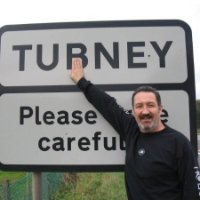Paul Turney
Paul Turney is best known as a member of the band Flight X-7 in the early 1980s.
Paul Turney was born 1958 in Cambridge, New Zealand, the third son of Dawn and Allan Turney. He lived in Bryce Street, then moved to 20 Victoria Road, and was schooled at St Peters Convent School followed by Sacred Heart College, Auckland. Turney played in the 1980s rock band Flight X-7 when they were looking to replace keyboards. In 1982 he was offered a studio job in the Gisborne Studio 'Capture' using 1" Otari MX7800 8-track recorder with MX505 1/4 inch mixdown, Eventide H949 Harmoniser, Yamaha compressor and Soundcraft 2400 8-buss mixer. His instruments: Yamaha CS30, Yamaha CS70M, Yamaha CP 80, Sequential Circuits Pro One. In 1983/4 Paul shifted to Wellington to play keyboards for The Body Electric, a false invitation that failed to materialise. He therefore began to work evenings in Marmalade Studios as a floating engineer under Dave Guinnane. He then worked on film sets in Auckland with Mike Westgate, and returned to Cambridge soon after. Turney opened a popular Pizzeria in Mount Maunganui until 1990. He then returned to Auckland to play in a small 'covers' outfit called 'Big Red Car' with Alastair Riddell of Space Waltz fame, meeting through their mutual friend Paul Crowther, the original drummer from Split Ends/Enz.
Turney moved to England in 1995 after a two year stint with Alastair Riddell, playing as a duo on the upper North Island circuit, and played for several years with the Variety Club of New Zealand on their week-long BASH to raise money for the Club. In that time it was thought, according to organizer Tim Kay, over 1.5 million dollars was raised for this charity. They used an old car rally format, with many NZ celebrities on a car race through New Zealand's small towns and cities.
Paul Turney went on to work in audio at London's Chop 'Em Out mastering studios, in West London's Cambridge Gardens. Chief engineer at 'Chop' was Simon Heyworth, who engineered Mike Oldfield's Tubular Bells. Chop 'Em Out was a Sony Professional beta-tester, and it was here DSD gained it's momentum. Other employees included Murray Harris and Phil Kinrade, ex-DJM engineers and others from the Marcus Studios when they closed. Turney began to specialise in archival techniques working on the Barbican's catalogue (UK Lottery funded) of live recordings over a two year period. He was also responsible for mastering records for release and was the resident vinyl expert. In the Millennia year Paul Turney was commissioned by Sony Broadcast and Professional UK to present the brand new Sony DMX-R100 digital audio mixer to the European arm of the Audio Engineering Society at the Paris Convention. He left London in 2000 and went on to win a contract with the British Library Sound Archive where he continued to work on obsolete technologies for eight years and is still a preferred contractor to The British Library. He lives with his wife and two daughters in an old stone house in the South Cotswolds, England, where he remains a much sought-after archival engineer. Recent projects have included the Ironbridge Gorge Museum Trust, Travellers (Gypsy) recordings from the Paul Wilson Collection (UK Lottery funded) at Wren Music, The Voyager Press collection of anthropological Wax Cylinders from 1904 in East Africa, the J Krishnamurti Foundation collection of recordings to be remastered for recent publication, and the life work of the musician Sting from various analogue and digital formats. Turney also has a recording studio on site with a fully equipped drum room, Underground studio, using Millennia Media preamps, Manley tube DI's and Studer valve technology. He has presented papers to the Society of Archivists (UK), and is a current member of the Audio Engineering Society.
